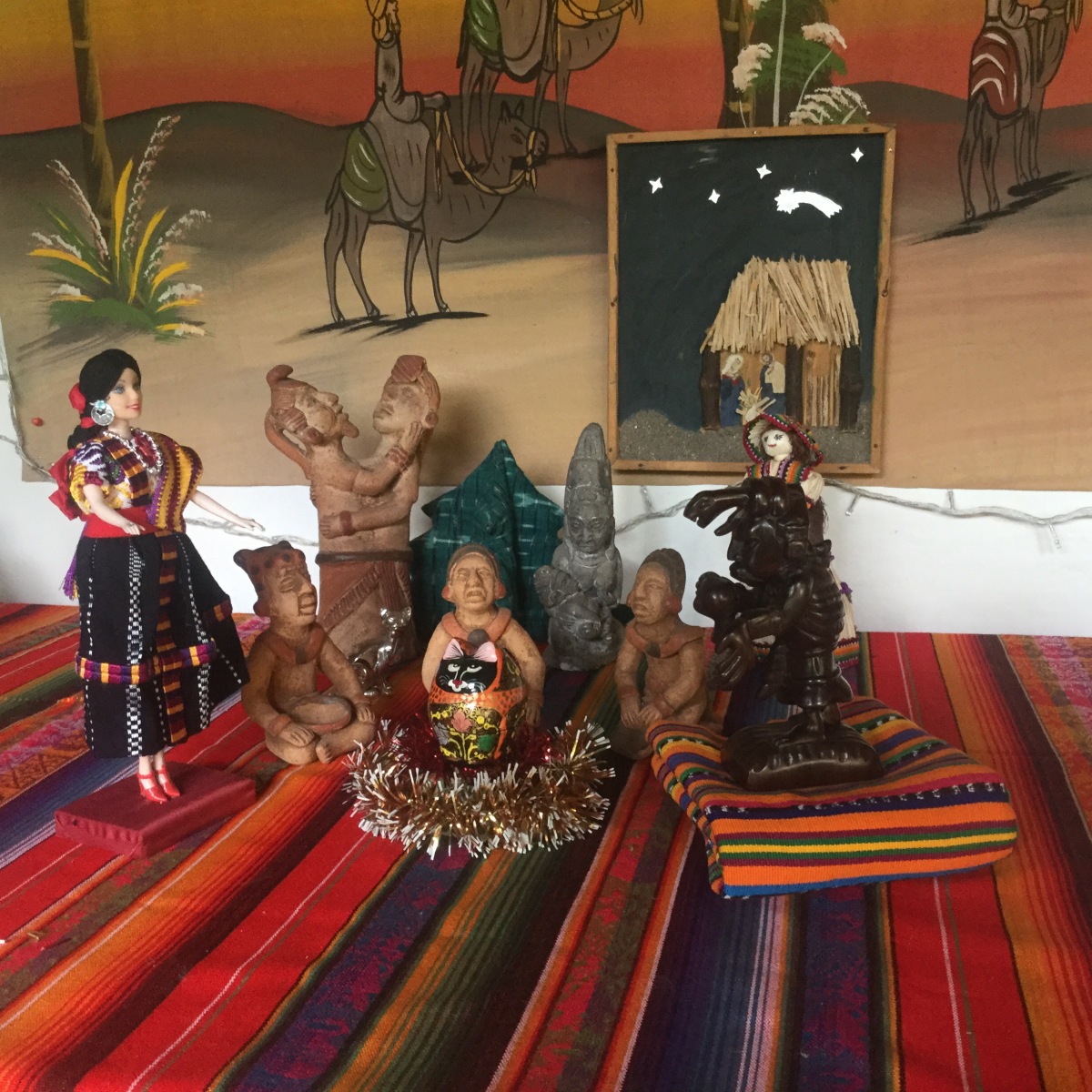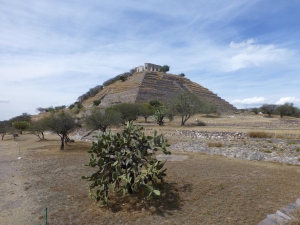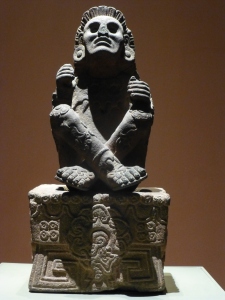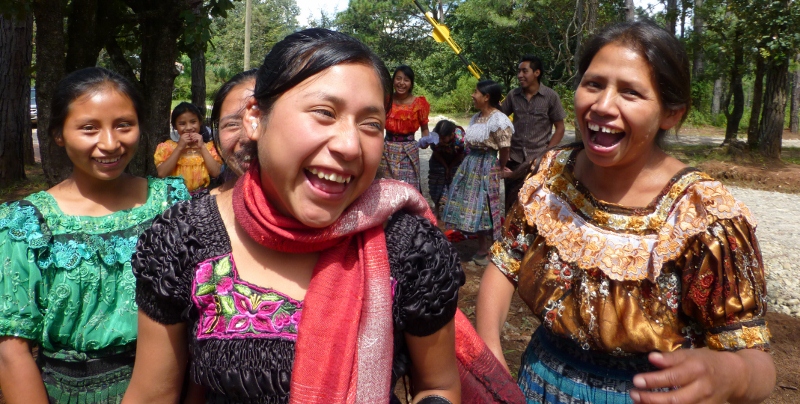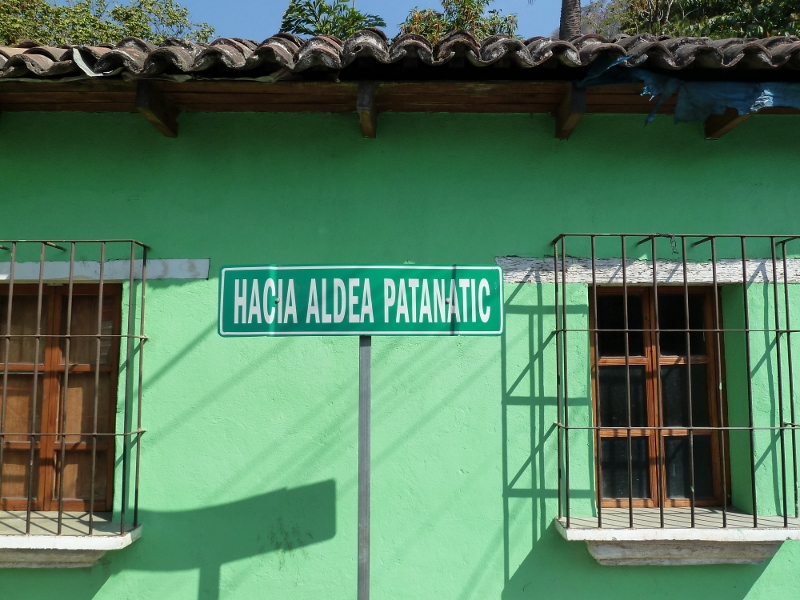All trainees develop the skills they study in class by treating hundreds of patients each time. On her last trip, Ms. Boccino presented the curanderas certificates detailing the hours each had spent practicing the different methods. A large part of The Integrative Health Project’s mission is to create a path for them to integrate the cost effective TCM treatments into their independent practices.
Espanole sigue
From the first days at the Barbara Ford Center for Peace, the ladies from Sacapiulus had appeared in their eye-popping traje (traditional dress.) Their head-wraps have four fat pom-poms that bob graciously as they joke in lyrical Sacapulteca, a dialect of the Quiche Maya language. For sure, Rosa Espinoza and Magdalena Pajarita stood out in the class of Health Promoters who came to study the treatments being taught by Dr. Joan Boccino’s teams.
Years prior, their townswoman, Sister Maruca, had bridged them into urban Santa Cruz del Quiche, where the religious woman lives and grows medical plants for her convent. It was Sister Maruca, who introduced them to BFPC’s Traditional Chinese Medicine (TCM) Program.
In order to attend the class sessions and to assist in treating patients during the clinical phases of the Jornadas Medica (Medical Workshops) Rosa leaves her eleven year old son with Magdalena’s grandchildren for a week while a teenage niece watches over them. The ladies need to make a few transfers to get out of their pueblo, Chuvillil, and then, they travel about an hour to attend the New York acupuncturist’s treating & training events. Since last year, there have been six missions instructing their class of local practitioners in the NADA protocol, moxibustion, gua sha, Qi Gong, forms of Tui-na massage and other “barefoot doctor” modalities.
All trainees develop the skills they study in class by treating hundreds of patients each time. On her last trip, Ms. Boccino presented the curanderas certificates detailing the hours each had spent practicing the different methods. A large part of The Integrative Health Project’s mission is to create a path for them to integrate the cost effective TCM treatments into their independent practices.
I became friends with this flashy gang and they invited me to visit them. I declined many times – mainly because my Spanish was too poor for me to understand them. But, now that I can even hobble along in Quiche I accepted when they wanted me to come and participate in their regular clinic. Even though we couldn’t secure any ear needles, the ladies had bags of medicinal seeds and the pierced boards to prepare them for insertion. I designed a sign for this event and would take great pleasure doing intake while they advised, counselled and treated. We four worked non-stop handling fifty three cases in six hours.
The last patients came in because they had seen the Global Clinic banner. This couple was the only “walk-ins” we got and they had a serious story to tell. He would answer the intake questions speaking softly and glancing desperately from me to Sister Maruca, who came over to listen with me. It seems that the wife had been hospitalized last year. After she was released she had lain in the bed for three months – losing muscle tone and suffering from constant migrains. .. She stared vacantly during this recitation. We all jumped to do something with this sad couple. Magdalena put seeds in their ears. And Rosa gave the husband a demonstration on how to do Gua Sha using a “special” TCM instrument — the round edged baby food lid. I would show him how to do the abdominal massage Chi Nei Tsang. We were all very happy to see the couple transformed and certainly more relaxed. As they left, they even asked when the next clinic would be held….
That afternoon, it rained too hard for us to take the easy way to their houses… The mud was just too slick for the truck to carry us in. So we walked. The three boys were waiting for Grandmother and Mom and they waved and hollered as they saw us tread into a clearing before the foot bridge (over white water.) After a mile of this through the quickening twilight I was gratified to see a tienda that sold beer – The bad news was that it was run by one of Magdalena’s cousins, who had been a patient that afternoon. She told me my money was no good and handed up 2 liters to give me thanks. Humbling.
My time up the country passed quickly exploring, chatting with the kids and waiting for Magdalena’s husband and daughter to arrive from the capital. One highlight of the visit was watching the treatment for a patient, who was diagnosed as “overly fearful.“ Magdalena looked around her very extensive medical herb garden and selected the plants that she would be adding to the patient’s steam bath. She then pre-boiled the several herbs and poured the hot mixture into a two gallon amphora. She set the liquid down in the space below a straight back wooden chair and dropped a rather unorthodox heating element into the vessel. She had hot-wired brick and attached it to an extension cord. She placed a tough grade plastic bag with a cinched neck and an open bottom over the whole assembly and explained that patient would climb in through the neck end of the bag and sit down with a towel over her head and face. The woman would take as much heat as she could and be cooled with a wash of clear water three times over about an hour. Rosa, the boys and I would take a walk down by the river while this was going on.
On the way through the fields, Rosa told me that the Civil War’s violence stayed pretty much on the more populous side of the wide river. But, there had been a time when organizers coaxed many of the farmers to form “resistance.” The unarmed men would “guard” the village from vantage points on the hills. Until one day, armed troops killed twenty or so of them. Rosa lost a cousin in this attack.
On the way, we would see her son’s father and she told a bit of her personal history.
“He has another woman and other children. From time to time he will greet my son but that is all.”
Rosa watches her brother’s house while he works in the city. The place has no cement stove but Rosa cooks her meals on an indoor fire-pit and the house has no latrine to generate night soil to enrich the small plot of milpas. But, Rosa remains joyous, resourceful and persistent. Before her son was born, she learned to read and began to take classes in Mayan medicine. Eventually, she developed a group of patients among her neighbors. After her son was born, Sister Maruca had taken special care to invite her to join Maruca’s cooperative because, as a single mother, she was being shunned by the women. These had been very hard times and Sister’s intervention made a big difference to her.
During the week prior to this, Magdalena’s daughter had been hospitalized in Guatemala City but was well enough to return home with her father, Don Miguel to celebrate her parent’s shared birthday. I had inquired about Don Miguel’s diplomas for perma-culture and Magdalena invited me to interview him about what he knew and how he came to build the elegant latrine. It seems that Don Miguel had been selected by AlterTec a US based NGO and was given an education in soil conservation, medicinal plant cultivation and sanitation in the 1980’s. in the years before the NGO left, they paid him to he teach these subjects. In the meantime, he used this knowledge, so that his family could enjoy richer harvests. These days Don Miguel commutes home once a month from his job in a plastic bottle factory. He came home bearing fresh seafood for his and Magdalena’s birthday feast. As I left, the grand kids were scaling and de-veining with a good deal of skill.
I am invited back in December to see the Mayan ruins that dot their land.
Support this work..
Continue reading “Sacapulus Health Promoters Profiles”
 Wise woman from Xela moves on up in her Red shoes to be Virgin.Mother. medicine God makes a fine Joseph and cat lovers promoted their candidate
Wise woman from Xela moves on up in her Red shoes to be Virgin.Mother. medicine God makes a fine Joseph and cat lovers promoted their candidate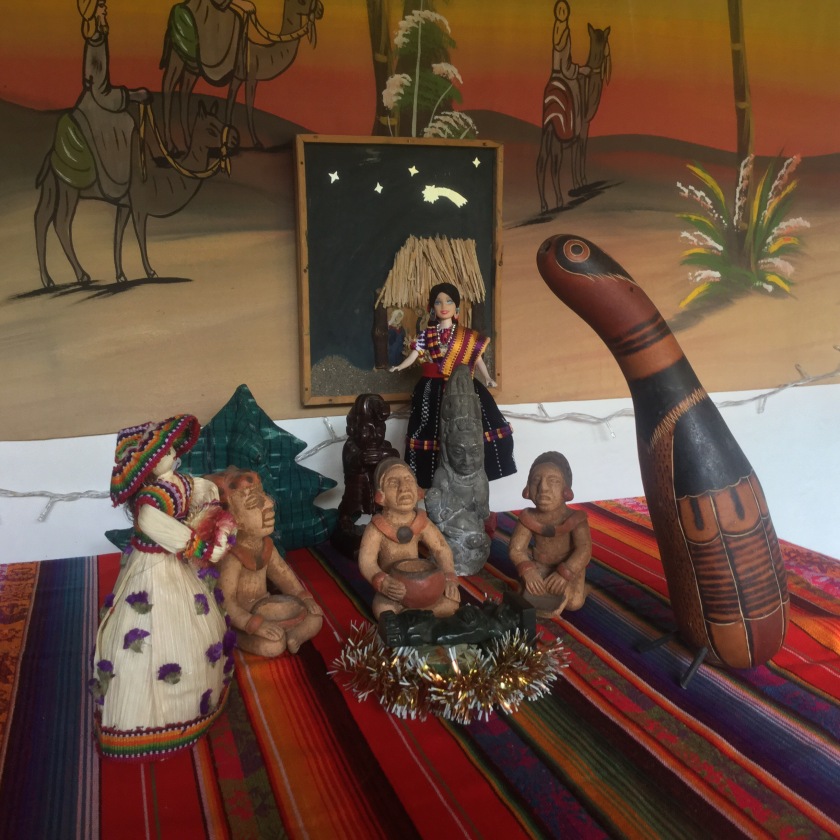 In this version a Peruvian gourd plays Joseph and Corn Lady stars as The Virgin Baby Jesus is Jade
In this version a Peruvian gourd plays Joseph and Corn Lady stars as The Virgin Baby Jesus is Jade Although the beige Baby is eye catching..collaborators jockeyed for a more subdued version
Although the beige Baby is eye catching..collaborators jockeyed for a more subdued version